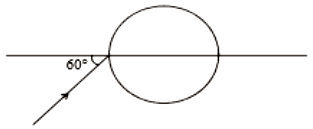The sun (diameter D) subtends an angle radian at the pole of a concave mirror of focal length f. The diameter of the image of the sun formed by the mirror is:
1.
2.
3.
4.
The focal length of the plano-convex lens is 20 cm. If its plane surface is silvered, then
1. it behaves as a concave mirror of focal length 10 cm
2. it behaves as a convex mirror of focal length of 10 cm
3. it behaves as a concave mirror of focal length 20 cm
4. none of these
A ray of light falls on a transparent sphere as shown in the figure. If the final ray emerges from the sphere parallel to the horizontal diameter, then calculate the refractive index of the sphere. Consider that the sphere is kept in the air.

1.
2.
3.
4.
A point source of light \(B\) is placed at a distance \(L\) in front of the centre of a mirror of width \(d\) hung vertically on a wall. A man \((A)\) walks in front of the mirror along a line parallel to the mirror at a distance \(2L\) from it as shown. The greatest distance over which he can see the image of the light source in the mirror is:

1. \(\frac{d}{2}\)
2. \(d\)
3. \(2d\)
4. \(3d\)
Two plane mirrors, A and B are aligned parallel to each other, as shown in the figure. A light ray is incident at an angle of at a point just inside one end of A. The plane of incidence coincides with the plane of the figure. The maximum number of times the ray undergoes reflections (excluding the first one) before it emerges out is :
(a) 28 (b) 30
(c) 32 (d) 34
A concave mirror of focal length 100 cm is used to obtain the image of the sun which subtends an angle of . The diameter of the image of the sun will be
(1)
(2)
(3)
(4) 100 cm
A square of side 3 cm is placed at a distance of 25 cm from a concave mirror of focal length 10 cm. The centre of the square is at the axis of the mirror and the plane is normal to the axis. The area enclosed by the image of the square is
(1)
(2)
(3)
(4)
One face of a rectangular glass plate 6 cm thick is silvered. An object held 8 cm in front of the first face, forms an image 10 cm behind the silvered face. The refractive index of the glass is [Consider that light ray returns back in the first medium]
(a) 0.4 (b) 0.8
(c) 1.5 (d) 1.6
One side of a glass slab is silvered as shown. A ray of light is incident on the other side at angle of incidence of . The Refractive index of glass is given as 1.5. The deviation of the ray of light from its initial path when it comes out of the slab is:
(a) 90o
(b) 180o
(c) 120o
(d) 45o
Two transparent slabs have the same thickness as shown. One is made of material A of refractive index 1.5. The other is made of two materials B and C with thickness in the ratio 1:2. The refractive index of C is 1.6. If a monochromatic parallel beam passing through the slabs has the same number of waves inside both, the refractive index of B is
(a) 1.1 (b) 1.2
(c) 1.3 (d) 1.4







